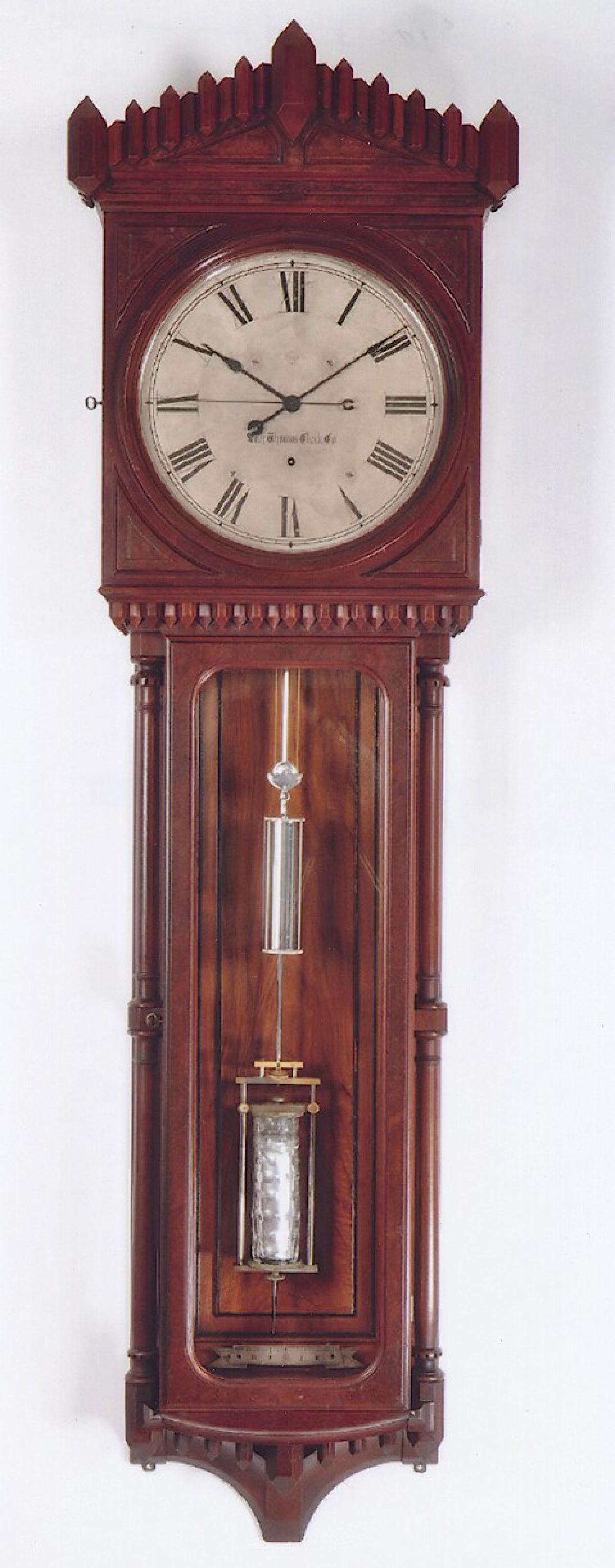Seth Thomas. Regulator No. 10. A precision regulator. 212037.
This very impressive clock is called the “Regulator No. 10.” This model is listed in the 1884 through 1904 Seth Thomas Clock Catalogs. This case clock hangs a full 72 inches long. Today, many collectors consider it to be Seth Thomas’ most desirable model.
This walnut example features richly-grained burl walnut veneers on all of the raised panels incorporated in the design of this case. A decorative pediment at the top of the case is a masculine form. The shaping resembles the outside walls of a frontier fortification used in the early 1800’s. Below this is a box that protects the movement and dial. The front panel is a door with a circular aperture centered in this location. This circular aperture is framed with a turned molding or bezel. This opening is fitted with glass secured by a nickel trim ring. It is through this glass that one views the dial. Large oval windows are positioned on the sides of the case. Through these, one can view the clock’s mechanism. The long, narrow section below the dial protects the weight and pendulum. The transition is nicely defined by the additional use of the molding profile at the top of the case. Much of this long section is fitted with large glass panels. The two located on the sides of this case allow additional light to access the interior. The glass panel in the case’s front is fitted into a large door frame. This opens to allow one access to the clock’s pendulum and weight. The viewer will also see the fantastic burl walnut panel mounted inside the case and make up the backboard. The framing for this door is decoratively formatted. Fully turned columns are mounted to the sides of the case. These help tie together the case design. The lower section of the case is trimmed with a similar molding that surmounts the top of the case. It is constructed in such a manner as to add a dimension of depth to the case design.
This heavy brass-made dial measures 14 inches in diameter. It has been silvered and is trimmed with a nickel ring. The silvering is in excellent condition. The engraved time ring features Roman-style hour numerals. The Maker’s name and trademark are also engraved on this dial. Three steel hands are mounted to the center arbor. This clock features a sweep second hand. Both the sweep second hand and the minute hand are counterweighted.
This Model No. 10 movement is among the finest that Seth Thomas produced. The large brass plates are in the shape of a trapezoid. The plates have been nickeled and polished to a high luster. The latter movements are not usually finished to this high of a standard. The plates are supported by four robust brass posts. These are attached to the plates with large blued, finished screws. The back plate is die-stamped with the Maker’s trademark. The date of “April 10th, 1882,” and the “No. 66.” The steel pinions and brass gearing are finely cut. The escapement is a Graham deadbeat format with jeweled pallets. The verge is fitted with a beat adjustment. This clock is also fitted with maintaining power. The works are mounted to an iron bracket, which is secured to the backboard. The cylindrical nickel finished weight hangs from a decorative pulley. This is an eight-day clock.
The pendulum is also hung from the iron bracket. The rod is steel and supports a decorative mercury-filled jar. The jar is cut glass in a thumbprint design. The superstructure that supports the jar is adjustable. A fine finished point at the bottom of the rod swings in front of a decorative beat scale mounted to the back of the case. It is brass and has also been silvered. The scale is engraved into the metal.
This fine clock, made in 1882, is a rare find. Measuring 72 inches in length, it is an impressive and exclusive piece that will surely stand out in any collection.
This clock, with its historical significance, excellent condition, and high desirability among collectors, is priced at $65,000, a reflection of its value and quality.
Inventory number 212037.
Seth Thomas was born in Wolcott, Connecticut, in 1785. He was apprenticed as a carpenter and joiner and worked building houses and barns. He started in the clock business in 1807, working for clockmaker Eli Terry. Thomas formed a clock-making partnership in Plymouth, Connecticut, with Eli Terry and Silas Hoadley as Terry, Thomas & Hoadley. In 1810, he bought Terry's clock business, making tall clocks with wooden movements. Seth chose to sell his shares in the partnership in 1812, moving in 1813 to Plymouth Hollow, Connecticut, where he set up a factory to make metal-movement clocks. In 1817, he added shelf and mantel clocks. By the mid-1840s, He successfully transitioned to brass movements and expanded his operations by building a brass rolling mill and a cotton factory. In 1853, He incorporated the business but continued to be the majority shareholder. This clock business expanded until it became one of the "BIG Seven" in Connecticut. Their product line had offerings that competed at every price point, from kitchen clocks to precision regulators. Seth Thomas died in 1859. The community of Plymouth Hollow so revered him that they changed the name on July 6, 1875, to Thomaston in his honor. After his death, his son, Aaron, took over the company's leadership. Aaron is credited with increasing the business by adding a number of new case styles and improving production methods. The company went out of business in the 1980s.




















